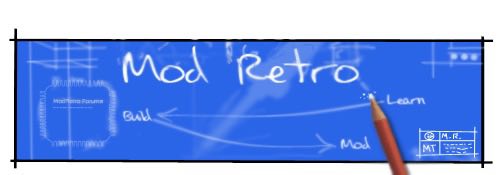The_Next_Guy
Active Member
This is my first guide on these forums so I am open to suggestions. I would also prefer if you asked my permission to post this guide anywhere else. I also take no responsibility for anything damage this causes. Anyway on to the guide.
Some people prefer using an Joystick or Slider instead of a DPad to give their project a smoother feel. I've seen some people ask how they would go about doing thism so I drew up a schematic on how:

Basic Logic: I use the LM339 IC as an Analog to Digital converter. It compares the value of the analog joystick with some fixed resistors. The way I have this set up is the circuit sources the output, when triggered, to ground which os what the gc controller requires.
The resistors in the diagram represent the deadzone of the trigger event. The Gamecube Joystick's pots have a constant resistance of about 10K Ohms. At neutral position the wiper of the pot between each side is about 5K Ohms. We then figure out which direction we are going. One side is 3.3V and the other is GND. The Joystick is positioned such that to the left and top is closer to GND, and that the right and bottom are closer to 3.3V. This will vary the voltage between GND and the wiper of the pot.
Using the resistors we can "emulate" the position of the Joystick at a certain position. Using the comparator we can compare the voltages between the resistors and the actual joystick. Think of the position of the fixed resistor is on a numberline. Now using our algebra skills we can come up with an equation that meets the position of the fixed resistor. The comparator will compare the fixed resistors to the actual Joystick. When the joystick is at or passed the fixed resistors it's output will go low.
If ypu like you can change the resistors for more or less sensitivity. Lets us define all resistors with the value of 6.8K Ohms as R1, and all the resistors with the values of 3.3K Ohms as R2. Important rules for changing these values are:
Now using these rules I can sugest 2 More pairs of resistors using the Gamecube Joystick, which is 10K Ohms total resistance.The first is R1 = 5.6K Ohms, and R2 = 4.7K Ohms. The second is R1 = 8.2K Ohms and R2 = 1.8K Ohms. Of course there are more combos that you can use but I stuck with standard resistor values.
Below is my video demonstrating the circuit.
This video will show you this circuit in action, but with the x axis portion only, as I can't plug both axies in my bread board. Thank you for reading my guide and Good luck portablizing!
Some people prefer using an Joystick or Slider instead of a DPad to give their project a smoother feel. I've seen some people ask how they would go about doing thism so I drew up a schematic on how:

Basic Logic: I use the LM339 IC as an Analog to Digital converter. It compares the value of the analog joystick with some fixed resistors. The way I have this set up is the circuit sources the output, when triggered, to ground which os what the gc controller requires.
The resistors in the diagram represent the deadzone of the trigger event. The Gamecube Joystick's pots have a constant resistance of about 10K Ohms. At neutral position the wiper of the pot between each side is about 5K Ohms. We then figure out which direction we are going. One side is 3.3V and the other is GND. The Joystick is positioned such that to the left and top is closer to GND, and that the right and bottom are closer to 3.3V. This will vary the voltage between GND and the wiper of the pot.
Using the resistors we can "emulate" the position of the Joystick at a certain position. Using the comparator we can compare the voltages between the resistors and the actual joystick. Think of the position of the fixed resistor is on a numberline. Now using our algebra skills we can come up with an equation that meets the position of the fixed resistor. The comparator will compare the fixed resistors to the actual Joystick. When the joystick is at or passed the fixed resistors it's output will go low.
If ypu like you can change the resistors for more or less sensitivity. Lets us define all resistors with the value of 6.8K Ohms as R1, and all the resistors with the values of 3.3K Ohms as R2. Important rules for changing these values are:
- R1 has to be > R2
- R1 has to be > half of the total pot resistance
- R1 + R2 has to be within ±5% of the total pot resistance
- R1 and R2 must be atleast 1K Ohm to be safe
Now using these rules I can sugest 2 More pairs of resistors using the Gamecube Joystick, which is 10K Ohms total resistance.The first is R1 = 5.6K Ohms, and R2 = 4.7K Ohms. The second is R1 = 8.2K Ohms and R2 = 1.8K Ohms. Of course there are more combos that you can use but I stuck with standard resistor values.
Below is my video demonstrating the circuit.
This video will show you this circuit in action, but with the x axis portion only, as I can't plug both axies in my bread board. Thank you for reading my guide and Good luck portablizing!
